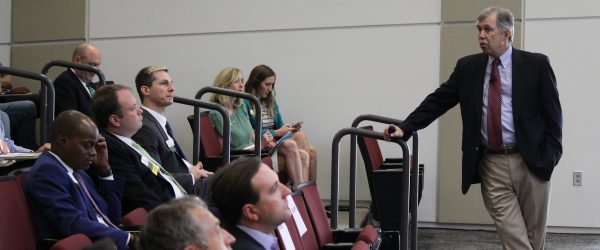UNC Charlotte economist addresses a decade of growth, offers forecast for the future

The economy of the United States and North Carolina, as of July 2019, is now experiencing the longest economic expansion since 1854. While at a modest rate, the national and state economies do continue to grow, and this consistent, decade-long expansion is significant, UNC Charlotte professor and economist John Connaughton said.
“This milestone of economic growth is noteworthy because it represents a consecutive decade of growth since the expansion began in 2010,” he said.
What North Carolina industries are benefiting the most from this continued economic expansion? Connaughton, a faculty member in the University’s Belk College of Business, said the data demonstrates that 13 of the state’s 15 economic sectors are forecast to experience increases in 2019, with the strongest expected in mining, information and business and professional services. The industries with the highest expected employment increases in 2019 are transportation, warehousing and utilities and other services.
“During the first quarter of 2019, Gross State Product (GSP) growth of 2.6 percent was still evident from the tax cuts put in place in January, 2018,” said Connaughton. “It now appears, however, that the economic increase from the tax cuts seems to be waning. In addition, the trade war with China is beginning to impact U.S. economic growth. While the trade war is getting substantial attention, the reduction in volume of U.S. exports to China is not enough to spin the economy into recession. Likely, the trade dispute impact will negate the 2018 tax cut benefits. This will return the economy to the 2 percent growth ceiling until the trade dispute is resolved. It appears that the trade dispute and the tax cuts are now offsetting influences on the economy.”
During the quarterly Barings/UNC Charlotte Economic Forecast, Connaughton transitioned from 2019 to 2020 and presented the economic forecast for the next 15 months.
“Going forward, the long-term growth question is dictated by two factors that are more influential than tax cuts or trade disruptions. The first is labor force growth and the second is productivity growth. Since 2010 the average annual U.S. labor force growth rate has been only 0.22 percent with the average annual productivity growth rate at only 0.78 percent. If the growth rate of these two factors continues at such a modest rate, the economy will be hard-pressed to continue even a 2 percent annual GDP growth rate,” Connaughton stated.
Likewise, for 2020, Connaughton expects North Carolina’s GSP to reach a level of $611,841.8 million, with the real (inflation-adjusted) GSP increasing only by 2 percent over the 2019 level. The state’s unemployment rate is expected to be 4.1 percent by the end of 2020, up slightly from 3.8 percent at the beginning of 2019.
With this trend, should a recession be expected? Connaughton said, “Despite the projected slowing of both the U.S. and North Carolina economies in 2020, the prospect for a recession is still slight. Consumer confidence remains high: Last month in August, the index settled at 135.1, down just slightly from July’s number of 135.8. With the national unemployment rate consistently below 4 percent, more job openings than job seekers, and lower gasoline prices than last year at this time, consumers have the discretionary income to keep personal consumption expenditures on an upward trajectory. In addition, the Fed appears to be ready to quickly counter any economic downward trend with lower interest rates.”
Connaughton presented his quarterly forecast to members of the Charlotte business community and the media at a luncheon held at UNC Charlotte Center City. The forecast is sponsored by Barings.
The full report is available at belkcollege.charlotte.edu/forecast. A new forecast video will be posted by Friday, Sept. 13. Connaughton will release the next Barings/UNC Charlotte Economic Forecast report on Dec.11.